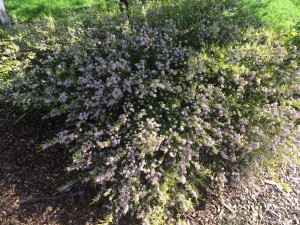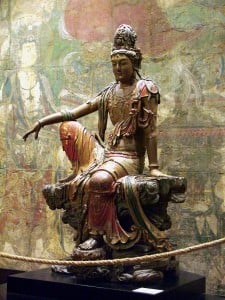
IMAGE: The planet Earth as viewed from space. Wikimedia Commons Creative Commons Attribution-Share Alike 3.0 Unported license.
Ode to Gaia
by E. W. Richardson
I woke to soft mists over the river,
A chilled, liquid, world where dew falls as rain
From the trees in muted musical notes
And the air is faintly luminescent…
A surreal place of contrasts and shadows
In pastel hues applied with a soft brush.
I kneel beside last night’s campfire and brush
Away ash, which settles on the river…
A fine, white, snow swirling in dark shadows
Of mist and water…a breeze brings more rain,
Drops hissing on coals, red and luminescent
As birds announce the sunrise with bright notes.
Upon my pad, a monarch reads my notes.
Later in the day, I will hear the brush
Of its wings in my mind, luminescent
Beats, which bubble in memory’s river.
Another breeze and more dew falls as rain,
Some glimmering pale gold in the shadows.
Slowly, the mists flow into the shadows,
There to sleep ‘till crickets play the first notes
Of tomorrow…dew is no longer rain,
Each drop a glowing gem at the first brush
Of the sun, which also turns the river
Into gold, molten and luminescent.
No better word would do…luminescent…
Glittering light dances where once shadows
And mists were pastels over the river…
And the music! Nature’s symphonic notes!
The birds, the river and the whisk-whisk brush
Of leaves form harmonies as soft, warm rain.
Sadness fills me and tears fall as rain.
These days are fragile things, luminescent
Once-was-could be’s…for man chooses to brush
Such beauty aside…he prefers shadows,
His music consists of discordant notes
Of waste which pollutes earth, air and river.
Beautiful the river! How sweet the rain!
I’ll record these notes in luminescent
Script and soft shadows, with my soul the brush!
Much like the idea of the big bang, Greek poet Hesiod’s in “Theogony” presents the story of Gaia creating herself out of Chaos, a primordial black void.
In June, British chemist and prolific author, James Lovelock, was honored at the Observer Ethical Awards for lifetime achievement. (Guardian U.K. article) The award recognizes his role in developing the Gaia hypothesis which he named after the Greek goddess. It is a model which became the basis of climate science.
“What is the hypothesis of Gaia? Stated simply, the idea is that we may have discovered a living being bigger, more ancient, and more complex than anything from our wildest dreams. That being, called Gaia, is the Earth.
More precisely: that about one billion years after it’s formation, our planet was occupied by a meta-life form which began an ongoing process of transforming this planet into its own substance. All the life forms of the planet are part of Gaia. In a way analogous to the myriad different cell colonies which make up our organs and bodies, the life forms of earth in their diversity coevolve and contribute interactively to produce and sustain the optimal conditions for the growth and prosperity not of themselves, but of the larger whole, Gaia. That the very makeup of the atmosphere, seas, and terrestrial crust is the result of radical interventions carried out by Gaia through the evolving diversity of living creatures.” “Gaia Hypothesis” by Stephen Miller UCD Energy Research Group
At the same time Lovelock and Margulis were working on their theory, Oberon Zell-Ravenheart (Otter G’Zell at the time) delivered a sermon to the Church of All Worlds congregation. The sermon reintroduced in a modern way the religion of Gaia. “THEAGENESIS: The Birth of the Goddess” detailed his vision of Earth as the living embodiment of a Goddess.
The difference between the science and religion of Gaia is that one states the planets biota is not purposefully self-regulating or conscious and the other does.
“CAW believes that the nature of our universe and planet is a manifestation of Divine being. As such the nature of human being is an expression of Divine being. In recognition of this we greet and honor one another with the phrase ‘Thou art God’ or ‘Thou art Goddess’.” “What is the Church of All Worlds?” by Iacchus, CAW Priest (retired)
To commune with Gaia is simply to be aware of where you are. Breath deep and you inhale the exhalation of the people and animals around you. The air of distant forests and evaporating water from rivers and oceans. To commune with Gaia is to stand in a swirl of dragonflies and watch as the sunset flashes off their wings or to bite into your food and really taste it. Taste it not just on your tongue as you swallow but feel the different sensations and tastes that arise as it moves across the different taste buds. Let the aroma rise through your whole body. To commune with Gaia is to squish your toes in the dew covered grass or mud of a riverbank. To gaze at the night sky and dance with her as she dances through the stars.
For more information about James Lovelock:
James Lovelock’s Website
Extensive list of books by or co-authored by James Lovelock















